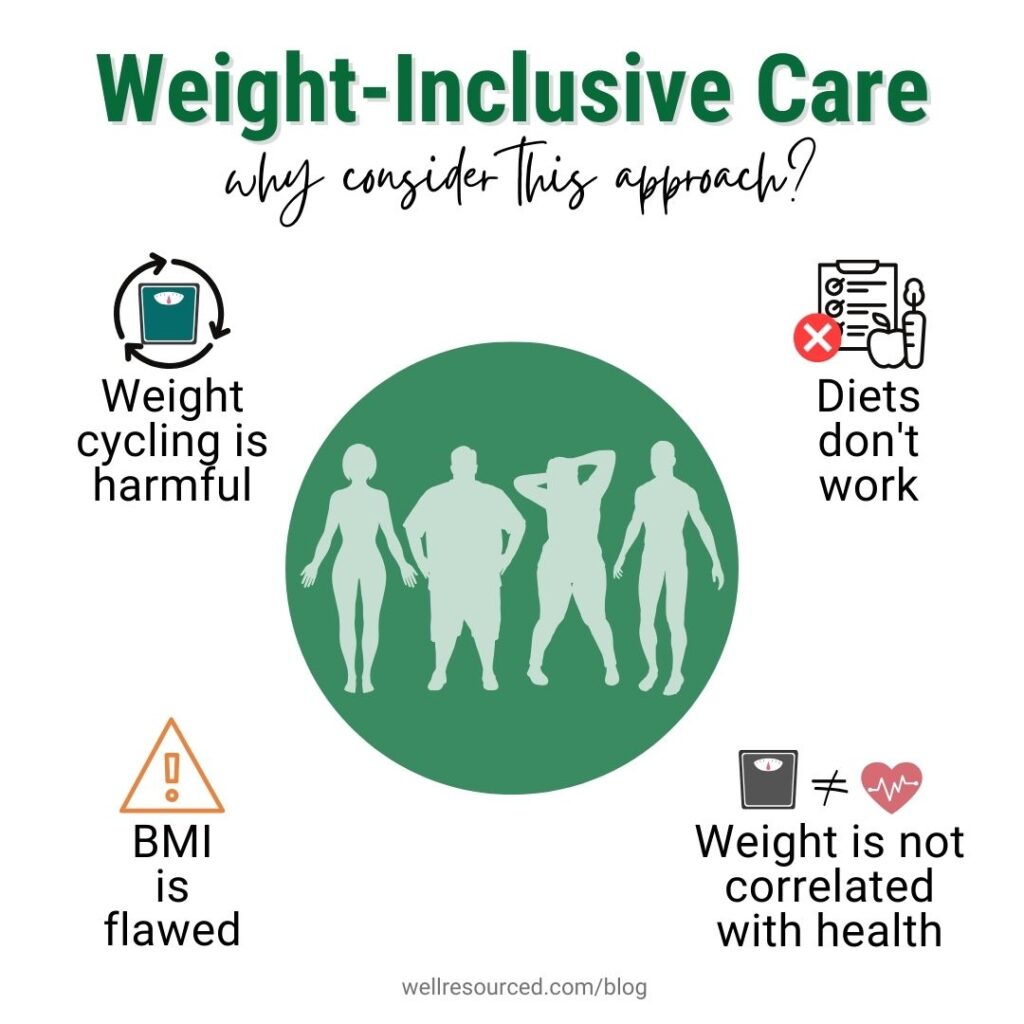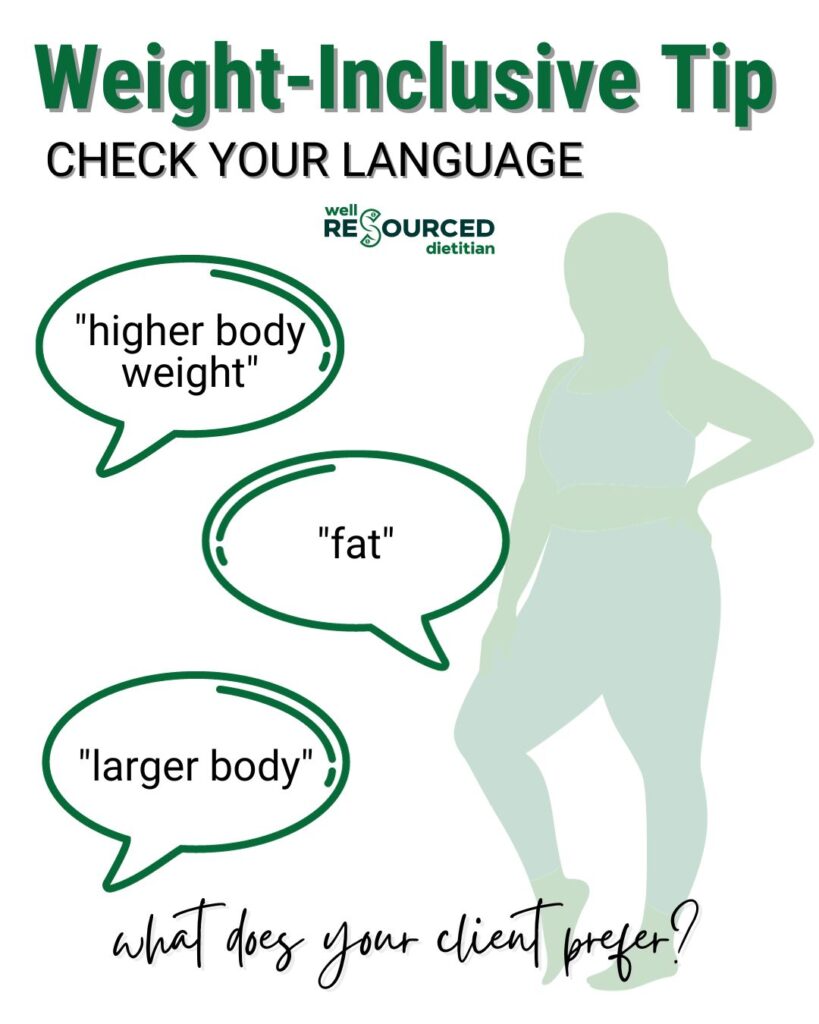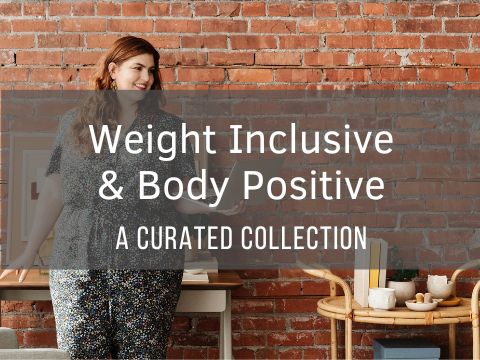When it comes to the weight-inclusive approach for dietitians, there is a lot of confusion. What is a weight inclusive approach and how is it different from nutrition counseling aimed at achieving weight loss?
With the support of Heather Caplan, RDN, founder of Weight Inclusive Nutrition and Dietetics (WIND) and host of the RD Real Talk Podcast, you’re in good hands to learn about weight-inclusive care. We will also be sharing expert quotes from other RDs who use a weight-inclusive approach.
Note: while we mostly chat about nutrition counseling for registered dietitians – our main audience here on WellResourced – a weight-inclusive approach is applicable to all health and wellness professionals, including nurses, doctors, personal trainers, and more.
And don’t worry if you feel overwhelmed about starting this approach – between the resources here and RD groups like Weight Inclusive Nutrition and Dietetics, you’ll find plenty of support.
Disclosure: This post was sponsored by Weight Inclusive Nutrition & Dietetics (WIND). Heather is offering her tips and expertise in this piece. As always, all opinions are my own.
What is a weight inclusive approach?
Most RDs were probably trained in a weight-normative approach, where a client’s weight is an important measure of health and wellness, and weight loss is a measure of success.
Weight-inclusive is a different approach to providing healthcare. With weight-inclusive care, you are not using a person’s weight to determine how healthy they are. This can feel really foreign to dietitians who are used to talking about weight on a regular basis with clients.
Heather Caplan explains:
“Weight-inclusive care operates from a weight-neutral standpoint. While weight changes are common and normal in a variety of client cases, those changes in weight are often, if not always, irrelevant to the care a client receives.
A weight-normative approach puts the emphasis on weight as a marker of health and prioritizes weight loss for health “improvement”. A weight-inclusive approach puts an emphasis on increasing access to respectful and equitable healthcare—not otherwise afforded to patients in what are considered “larger bodies” in the weight-centric space—and instead prioritizes client-centered care, and approaches health “improvement” (when relevant) with health-promoting behaviors and various biomarkers that don’t center around weight.
Kayley Meyers explains further:
“The biggest difference between a weight-inclusive approach and a weight-centric approach is acceptance. In reality, nutrition recommendations are often similar with both schools of thought: incorporating nutrient-dense foods, blood sugar balance, physical activity, etc. Weight-inclusive practice allows for the pursuit of health in all body sizes. For many people, their healthiest and most sustainable size is above what may be accepted by current medical recommendations. Weight-neutral care helps take guilt out of the equation and empowers patients to create habits that care for their here-and-now body.”
Kayley Meyers, RDN
With either approach, there can be overlap in recommendations, such as emphasizing habits including more vegetables, stress reduction, and so on, but the two approaches will vary in how much of an emphasis they put on the scale.


Weight-inclusive terminology
As we are getting our bearings on this topic, we are offering a few definitions so that you can get the most out of our expert quotes and further reading.
- Fatphobic – judgment, and fear of fat people, which can lead to discrimination and mistreatment.
- Weight neutral – weight-neutral or weight-inclusive, is an approach to health that starts from the premise that all bodies are good bodies and deserving of respect.
- Weight stigma – Weight stigma is discrimination or prejudice against individuals based on their weight. This can manifest as fatphobia, weight bullying, and assumptions about an individual’s health or character.
- Diet culture – is a system of beliefs that value thinness and equates it with health and moral virtue while demonizing fatness. Diet culture tells us that weight loss is good and weight gain is bad.
- Straight sized – able to fit into most clothing available in stores, able to sit comfortably in most furniture, can fit comfortably in airplane seats, etc.
- Healthism – the idea that a person’s health and wellness are entirely their responsibility, ignoring external factors that are outside of their control, such as access to a grocery store.
- Body privilege – your weight has not often or ever been discussed as a problem by healthcare providers, you have not experienced weight stigma and your body size isn’t a consideration for how you experience things, such as being comfortable in an airplane seat, being able to wrap yourself in a hotel bath towel or fit comfortably in a restaurant booth.
With either approach, there can be overlap in recommendations, such as emphasizing habits including more vegetables, stress reduction, and so on, but the two approaches will vary in how much of an emphasis they put on the scale.
Why use this approach?
Proponents of a weight-inclusive approach point to several reasons that this approach is a better fit for our field. Here are a few reasons to consider a weight-neutral approach.
Weight is not correlated with health
Heather explains that “we have ample evidence showing us that intentional weight loss is not only ineffective long term (meaning that the majority of people who lose weight gain it back) but also that repeated weight-loss efforts result in weight cycling (loss, gain, repeat).
Heather is not the only expert pointing to the flaws in BMI.
BMI is flawed
BMI – which stands for Body Mass Index, is a calculation of a person’s height compared to their weight.
Did you know that BMI was never meant to be used in healthcare?
The BMI formula was created in the 1830s by a man named Adolphe Quetelet, who was a Belgian mathematician, astronomer, and statistician. He came up with the idea of BMI as a way to measure obesity in the population for insurance purposes (1).
And our weight-neutral RDs agree:
“BMI doesn’t take into account body composition, physical activity level, body type, age, genetics, cultural diversity, access to health care services, socioeconomic status or ethnicity. It’s really just another number–like body weight–that doesn’t tell us anything about a person’s health status.” –Melissa Nieves, LND, RD, MPH
Diets don’t work in the long term
Weight cycling – or “yo-yo dieting,” – is when someone loses weight and then gains some, all, or more of it back. This can happen multiple times throughout a person’s life.
Weight cycling has been linked to an increased risk of obesity, cardiovascular disease, type II diabetes, and all-cause mortality.
A weight-inclusive approach allows us to focus on health behaviors instead of the scale.
Heather explains: “Eating nutritious foods, intuitive eating practices, gentle movement, stress management, medication adherence, preventive screenings, etc. are all things that any patient may have access to and/or could focus on, without the priority of weight loss.”
Weight stigma is harmful
Weight stigma – society’s judgment of someone based on their size – has been found to cause harm (5). Stigma comes from friends and family, healthcare providers, and the work setting. Weight stigma impacts mental and physical health (6).
Weight stigma can also be a barrier for patients to seeking the care that they need (7). Healthcare practitioners’ weight stigma can cause harm.
“Recently, a patient complained to me about how her attending doctor complimented her on her weight loss, first thing upon walking into the room. I happened to visit with her after and she tearfully explained that the rapid weight loss is not intentional and the doctor overlooked the tremendous strides she was making with rehab (therapy) and weaning off high supplemental oxygen. This is a clear example of the harm caused by fat phobia and weight-centric philosophies. “ – Johna Burdeos, RD
You may be ready to learn how to become more weight-neutral in your own practice. Let’s cover some ideas to get started.


How to create a weight-inclusive practice
You can explore a weight-neutral practice, starting today! In this section, we include business tips to align your practice with weight inclusivity as well as tips for your counseling sessions.
Business tips
No matter your niche, here are some ways that you can make your practice more inclusive to people in diverse bodies.
Consider your furniture – if your practice is in person, make sure that your furniture is comfortable and accessible to people of different sizes. Small chairs with tight arms are not accessible for people with larger bodies.
Consider your keywords – on your website, include language to describe how you help people of all shapes and sizes. For example, “nutrition counseling for people of all sizes” or “weight-neutral nutrition counseling.”
Explore your assumptions – avoid making assumptions about your clients’ weight or health based on their size.
“Don't make assumptions about your client based on their appearance. Our weight-centric society has taught us many of these assumptions and we are all works in progress. Notice your own prejudices and continue to confront them so that you may serve every single client with the dignity and respect they so deserve. That thin client may not eat any fruits and vegetables and may have high cholesterol; your client at a higher weight may have excellent cholesterol and A1c. They may walk daily and cook their own meals, including lots of fruits and vegetables.”
-Kelly Abramson MS, RD, CHWC
Skip the scale – unless weight will influence your nutrition recommendations (as with eating disorder recovery), don’t weigh your clients or offer blind weights, so the client does not see the number
“I rarely talk about the scale with clients. I find that a scale is a tool that deep down people use to measure that they will never be good enough. This is FALSE! And the weight-centered treatment perpetuates this false belief. My goal as a provider is to give them tools to be their best healthy self - outside but also inside.”
Elizabeth Ray MS, RDN, LD
Marketing – write social media messages and emails in a way that feels inclusive and rejects diet culture.
Network – connect with other healthcare practitioners so that you can be referral partners to one another, continue to learn from one another, and have a sounding board when you need support.
Get support – get support from other RDs in weight-inclusive dietetics by joining organizations like Weight Inclusive Nutrition and Dietetics (WIND).

Counseling tips
As you’re working with clients, these tips will help you to be weight neutral in your approach.
Focus on behavior changes rather than weight – Heather explains, “we see various improvements in biomarkers of health regardless of weight loss when practitioners instead focus on health-promoting behaviors without a focus on weight loss.”
Don’t assume weight loss is their goal – “Don’t assume a patient is interested in a weight loss diet even if you get a consult from the doctor for it. Ask open-ended, neutral questions like: “What questions or concerns, if any, do you have about food and nutrition?” Versus “Are you interested in losing weight?” – Johna Burdeos, RD
Get supervision – if you work with clients, you can consult with peers and/or fellow weight-inclusive practitioners for supervision.
Heather has a whole podcast on this topic linked here: Episode 186: Real Talk About Clinical Supervision with Haley Goodrich, RDN, CEDRD-S
Check your language – With clients, it’s often helpful to ask what language they feel comfortable with. We used *fat, above, as a neutral descriptor, but not everyone wants to use that term. Larger body, or higher body weight, are often used/preferred in place of the BMI categories that carry stigma (e.g. “overweight”, or “obesity”). But again, some patients may simply prefer “fat”.
Share body-positive fitness resources if the client is looking to start exercising. We have a whole round-up, right here: Body-Positive Workouts and Fitness Resources.
Consider incorporating Intuitive Eating principles into your practice – Intuitive Eating, a related approach, also focuses on health outside weight. You can learn more about this approach right here: What Does an Intuitive Eating Dietitian Actually Do?
Don’t assume weight loss is intended or healthy. Lisa Andrews, MEd, RD, LD shares a recent client experience:
“I had a client with obesity that had severe food allergies, MAST cell syndrome, and POTS. She had unintentionally lost 60 pounds and was afraid to eat due to anaphylactic reactions.
She was getting so weak and dehydrated, that she could no longer work. We talked about her condition and decided that a temporary feeding tube might be appropriate to prevent further weight loss. When I approached her MD about it, he responded, “she’s not malnourished because she’s obese per BMI.”
He’d completely ignored that she’d lost 60 pounds and couldn’t eat. He only looked at her BMI and not the overall picture.
The patient continued to lose weight and finally got a G-tube. I was furious with this doctor, and so was the patient.”
Resources and references
As you are ready to explore and incorporate weight-inclusive practices into your nutrition counseling, check out these recommended resources and references.
- RD Real Talk Podcast – Heather Caplan has launched a successful podcast with many expert interviews available today. Here are a few episodes you might consider diving into, first.
- The Association for Size Diversity and Health (ASDAH) – a non-profit organization membership that is open to practitioners and consumers alike. ASDAH offers incredible trainings, teach-ins, and conferences. ASDAH is the home for all things Health at Every Size® (HAES)
- Weight-Neutral products on WellResourced – a few of our favorites are listed here:
Final Thoughts from Heather
Heather leaves us with a few thoughts as we consider a weight-inclusive approach in our own practices:
“It is important for clinicians to acknowledge how their own lived experience impacts the limits of what they can provide to some clients, and accept the humility that comes along with that, particularly as dietitians who may hold multiple privileges (thin, white, cisgender, financially secure, etc.). It doesn’t mean that a provider with these privileges can’t offer counseling to any clients, but in order to do that effectively and ethically, we encourage ongoing learning in the anti-oppression space and supervision.”
Heather Caplan, RD
Key Takeaways for a weight-inclusive approach
Many dietitians have joined the profession out of a desire to help others. As a field, we continue to learn more about the best ways to do that, without the risk of harm.
Learning how to better incorporate a weight-inclusive approach into your practice is an opportunity to support your clients on their journey to achieving better health without the harm of weight cycling or weight stigma.
WellResourced is your destination for client resources created by experts in all niches, including weight-neutral practice. Browse our stores to find the perfect slide deck for your next presentation and handout for your clients, without having to make it yourself.
And as you create your own resources, let them work harder for you by opening your own shop. Make revenue while you sleep as your fellow dietitians learn from you and shop from your store. You can become a vendor today and start sharing your digital products.







